iModeler Review: Kitty Hawk 1/48 F-101A/C Voodoo
This is taken from my review at Modeling Madness, with the complete collection of photos here.
Over the years, there have been a few kits of the McDonnell F-101A/C Voodoo, starting with - if I recall correctly - a box-scale kit from Revell some 55+ years ago. Hasegawa released a 1/72 RF-101C in the 1960s which became the subject of one of the first resin conversion sets in the 1980s, released with a set of decals by Super-Scale for the fighter. Following the release of the 1/48 F-101B by Monogram, Bill Koster released vacuform conversions to do both the F-101A/C and the RF-101A/C. Moving on, C&H Aero released a resin conversion for the Monogram kit to create both the F-101A/C and the recon birds some ten years ago. This kit from Kitty Hawk is the first designed-for-the-purpose F-101A/C kit in 1/48 and has been the subject of much speculation.
In the box, as is the case with all Kitty Hawk kits, it looks pretty good. Crisp moldings, a minimum of flash, lightly-engraved surface detail, a good decal sheet - this one presenting F-101A and F-101C aircraft from each of the four squadrons of the 81st Tactical Fighter Wing, the only Air Force unit to operate the fighter-bomber Voodoo. It is pretty certain from the contents of the kit and the breakdown of the design that an RF-101G/H and perhaps the RF-101C will be released down the line.
For starters, one has to realize that Kitty Hawk is the only model company that designs its kits to fit a standard-size box, which is backwards from every other company who order boxes to fit their kits, and leads to some very strange kit design decisions. Most particularly in this case, it leads to the long Voodoo fuselage being divided in thirds, rather than produced in two halves like Monogram did. Even more strangely, the forward and aft thirds are divided vertically, while the center is divided horizontally.
As one proceeds with the assembly, the old Kitty Hawk problem encountered in all their other kits raises its head. NOTHING FITS! Thus, I am going to outline to you what I think is the way to go about building this kit, rather than the way I built it, since that was a process of discovering that I had wandered into the plastic kit division of the Wong Fook Hing Book Store.
For starters, consider this a Classic Airframes kit with better molding but otherwise just the same. Cut off all the locating pins, since they mis-locate what you're trying to fit. Do not, however, cut off the pins on the lower forward fuselage, since they are of some important help in trying to get that lined up so you aren't spending for-bloody-ever trying to get rid of that seam.
Since the dive brakes are short-shot, and (along with everything else!) don't really fit, I suggest you close them. Most of the photos of F-101s I found have them closed. Do this before you assemble the rear fuselage halves. Fill all the sink holes, sand the brake smooth so it is smooth to the fuselage, then rescribe the outline. (One good thing to make note of here before proceeding further is that you do not have to get the surface so smooth to accept a NMF finish - the F-101 only ever served painted in Coroguard, which weathered quickly in service over in England and Europe.)
Assemble the upper rear fuselage halves, and then attach the lower hot section to that. Do not attach that lower part to the lower center fuselage as the instructions say.
Moving on to the wings, the flaps can be assembled down, but there's not much holding them there. While they present a blob of bright color - being red inside - most photos of Voodoos show them raised, and it does let the speedy-looking lines of the airplane come through. If you should choose to do this, glue the flaps into position in the lower wing BEFORE any further assembly, so you can work the fit from inside and outside and get right (I definitely learned this the hard way. Once you have made your decision on the flaps, assemble the inner bulkhead to the lower wing half and then assemble the two wing halves. If you followed my advice and trimmed off the locating pins, you should be able to get this fitted nice and tight without any putty needed anywhere.
It's now time to consider the center section of the fuselage. Do not assemble the inner engine and then attach it inside as the instructions say. Cut off the locating pins on the inner engine parts once assembled and put them aside. You're going to be much happier assembling each engine completely and then sliding it into position. Also, sand down the intake inserts so they will be flush with the rest of the part when attached. Get them about half as thick as they are.
Once you have glued the upper and lower halves of the central fuselage together, attach the rear fuselage. Be very careful in fighting these two sub-assemblies together, to maintain proper alignment and insure that the vertical fin is indeed vertical, and that you do not have a “banana” going with the fuselage.
And now we come to the joys of the forward fuselage. Once you have painted and assembled and decaled the cockpit tub, set it aside. Now proceed to assemble the three parts of each fuselage half separately, so you can work their joints from inside and out; if you do that, you will get good fit and not be stuck sanding seams and rescribing. Personally, I think having the refueling probe out destroys the look of the airplane; you may decide differently. I glued each of the doors of the probe compartment to their respective fuselage halves at this point, since I could get them nice and smooth working both sides of the joint.
After you have assembled the nosewheel well, DO NOT ATTACH IT TO THE COCKPIT TUB. If you follow the instructions, neither assembly will align with its proper opening in the fuselage. Sand down the top of the wheel well to reduce the thickness by about half. Do the same thing to the cockpit tub floor.
Then glue the wheel well in position and let it set up, being sure the vertical alignment is really vertical. Then slide the cockpit into position. With the “wiggle room” created by getting the cockpit floor and wheel well roof thinner, you should be able to squeeze the cockpit tub into proper position. Once you have it in position, then glue it with CA glue and zap it, and hold it while it sets up to be sure it stays in position (that's because it doesn't really want to do that, due to molding flaws).
You won't need a lot of nose weight here to guarantee nose sitting. I put in one medium-sized “cannonball” fishweight and all was well. Put that in ahead of the wheel well. Now carefully align that lower fuselage together, and take the time to get it really right. Then glue the lower seam together. If you did it right, and use hot glue, you won't have much of a centerline seam (you might even not have one. Now squeeze the upper fuselage together around that @#$%%$#$#@! Canopy tub, get it aligned, and glue it. You will want to use several large rubber bands to hold all this together. Let it set up completely before further handling.
You now get to discover that the radome is round in section, while the forward forward fuselage is slightly oval. Enough to make things not fit. I glued the radome on, then sanded it to fit the fuselage. It really should be round, but there's more fuselage than there is radome, and this way you don't have to rescribe a lot of surface detail from having added putty. Not to mention, no one will notice the cross section of the radome.
Once all this is done, carefully fit the forward fuselage to the rest of the fuselage. You'll be doing some industrial-strength pushing and shoving here, but be sure that the alignment is such that the vertical line of the forward fuselage really is vertical when you get it in position, and also check that “banana” problem. Run glue around the joint, lots of it. Then use a wide rubber band, “spear” it on the nose and have it wrap around the tail cone. Be certain you haven't got a “banana” going, and let it set up thoroughly before further handling.
If you have done all this right, you won't be using much putty, but most likely you will be puttying the upper centerlines of the forward and aft sections, and the joints bringing the three sections together. With luck, there won't be much. Again, you don't have to worry about a fuselage surface for a NMF paint job.
When the fuselage is set up, it's time for the wings. Once I had them in position and ran glue into the joints, I then wrapped rubber bands around the forward sections of the intakes, and one larger one wrapped around the wingtips, to keep the wings tight against the fuselage while the joint set up. Again, be sure you have proper alignment before leaving it alone to set up.
And then there are the engines. Again, NOTHING FITS. The various panels that fit over the burner cans have gaps, no matter how you play with them to get them right. I ended up using more filler here than I used on the entire rest of the project, and then rescribed things. I glued the inner part to the burner can and wrapped each with a rubber band to get a tight fit. The exterior of the burner cans was painted with Tamiya “Bronze,” “Titanium” and “Gun Metal.”
You're now headed for the finish line, assembly-wise and with luck, the atmosphere over the workbench is only a light shade of violet, rather than the deep purple with lightning bolts and thunder that I experienced.
I left off the gear and the horizontal stabilizers till after the model was painted and decaled.
At the point of painting, my model showed the physical effects of having discovered all those neat little tricks described above “the hard way.” I wanted to hide the thing under a paint scheme that would distract the viewer. Fortunately, I had a photo of the very airplane I was going to do, taken in 1965-66, after 5-6 years of operation in European weather. The Coroguard was “ratty.” And it was multi-hued.
I mixed some Tamiya “Gloss White” with “Flat Aluminum,” and painted the various panel areas on the fuselage. I then masked those, and gave the model an overall coat of Tamiya “Flat Aluminum” from a fresh bottle (nice and smooth). I then made a thinned mix of the “grey aluminum” and “blotched” the upper surfaces of the flat aluminum areas.
I then masked off and painted the “exhaust” area with Tamiya “Titanium” and left it glossy. I gave the rest of the model a coat of Model Master Sealer to keep the surface nice and smooth for decals, without getting it shiny.
The decals go on easily. Be sure to use lots of water on the surface area you intend to place them, because they will grab onto the first dry surface they find and stay there. I only needed a very thin application of Micro-Sol to get the decals to snuggle down. They have a flat(tish) finish that worked perfectly with what I had created, so there was no need for further varnishing.
I found with the nose wheel assembly that I had to trim the mounting pins, so the assembly would slide into the wheel well properly.
Then I found out that the mounting pins for the main gear are too big for the holes, which are not deep enough to seat the gear fully, and if you do that, the gear will splay so that you have “duck feet” with the main wheels. I cut off the pins, mounted the main gear legs with CA glue and braced them with the rest of the gear in the well. The gear doors managed to go on without problems.
I slid the engine exhausts into position and used CA glue to mount them. I then attached the horizontal stabilizers.
I assembled the canopy closed because it looks better that way and there is not that much to be seen inside. You may want to display yours open if you get the True Details resin Voodoo ejection seats, which will really improve the look in there.
I attempted to attach the little vanes that go to the sides of the nose, but they both broke when cutting them off the sprue. At that point I declared victory and crawled off whimpering “Let me up, I've had enough.”
Kitty Hawk kits remind me of Charlie Brown and the football. "It's gonna work this time! It's gonna be good! I'm gonna kick that ball!" And then...
At least this one didn't end up where the last two attempted Kitty Hawk projects did. It's now out in a glass case at Planes of Fame, where no one can see all the trouble, and it looks like an F-101 to any observer.
I am sure anyone with the burning desire to have a Voodoo in their collection can do this. But go into the project with the knowledge that it's not a mainstream injection-molded kit. Think of it as a Classic Airframes kit that looks better and fits about the same.
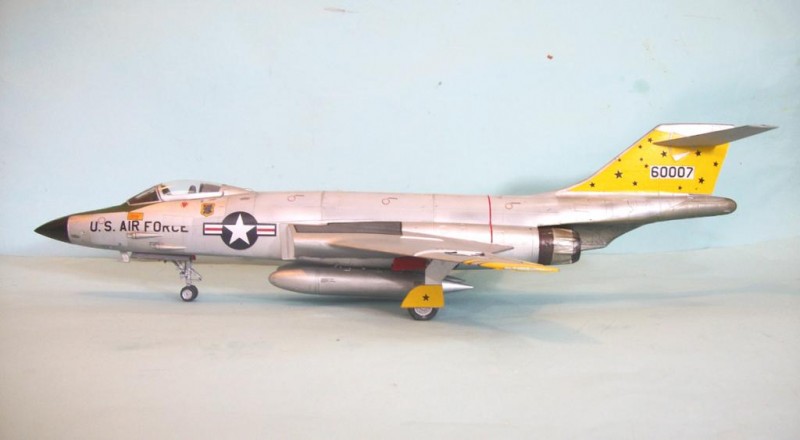
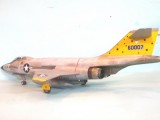
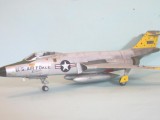
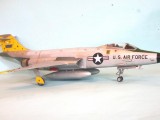
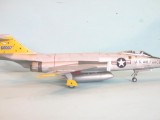
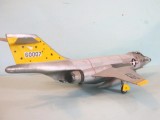
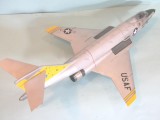
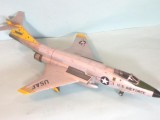
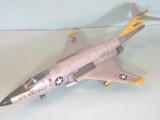
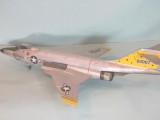
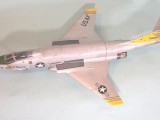


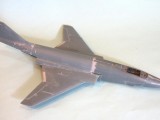
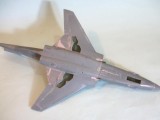
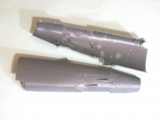
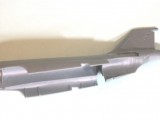
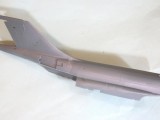
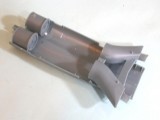

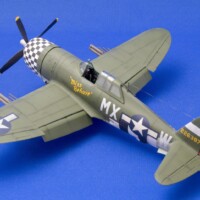
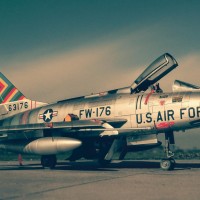
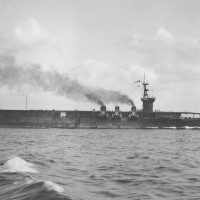
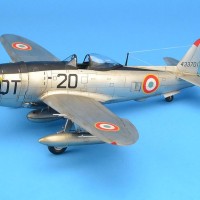
Sorry for all your troubles Tom but it certainly is a cool looking aircraft! And it proves that there still are industrial processes that need both special skills and quite a lot of experience: Injection molding isn't easy. I am sure that all their 3D material fits perfectly, it's just the transfer into plastic reality that's a bit iffy...
I had lunch with a few modelling friends yesterday and the KH Gripen was discussed and dismissed with the words "one of the most horrible models I've ever built". And like the 101, it looks very nice in the box!
Regards
Magnus
You have hit the problem square, Magnus. For all that the model might end up looking nice in the end, one can't look at it without remembering all the fun that got lost.
Just finished a Zvezda Bf-109F-4, which everyone calls "fiddly". There are a lot of parts but THEY ALL FIT. It was fun. From beginning to end.
Nevertheless, it looks the part.
Since I don't build to many 1/48th scale jets I won't be frequenting your favorite book shop. I usually manage to find my way into the 1/72nd department in the basement.
Good review though & hopefully it will save some builders your frustrations.
Was wondering how long it would sit on the S of D. Looks good from my view, and your write-up has saved me the expense of purchase and the agony of the build. Fortunately my impending move from Florida to Houston will give me a "time out" and maybe the magic will return sometime in the future.
Thanks for sharing.
"...nothing fits..." and "...don't follow the instructions..." and the various other negative descriptive comments sound very much like an appropriate review for Kitty Hawk's F-35B (which is on MY 'shelf of doom' and will most likely remain there until/unless another manufacturer offers a better [read: couldn't get much worse] version, in which case I may, I say MAY, use some of the KH parts for spares).
I've seen what appeared to be pretty good builds of the F-35B, but my example pretty much sucked. Perhaps the "A" model was better (?).
No, all the F-35 Armadillo (Its real name) kits suck.
TC,
This has got to be the longest article on how to correct a review kit I've ever read and for 85.00 dollars U.S. Ouch. However, from the photographs it looks like you beat the beast and the model does look presentable.
Two thumbs up for the builder.
Sounds like this was quite a challenge to complete and to get it to look right, which it does to me. Probably not a good kit for a beginner, but maybe a good build to someone, like yourself, who knows the modeler's tricks to make it work. Thanks to your review, those who want to build this kit are now forewarned. Still, I get a lot of satisfaction from difficult builds when they turn out good, so my order is in for this kit.
I am glad that I wont be buying this kit. After all the miniscule difficulties I am having with the F-94 I doubt that this would be any different. I am just pondering the purchase of their AT-6 now. So it is easy to say I am some what disappointed.
I know a guy who has built two T-6 kits (does them for owners of 1:1's). He has a whole set of instructions that start with "throw away the instructions." For anyone who has been around a real T-6, how they got the landing gear wrong (too inboard) and even the tailwheel design wrong, is beyond me. The more I look at the one I have here, the less enthusiastic I get about building it. Not to mention they chose warbirds for the decals and two of the four choices are the wrong sub-type.
Tom, you certainly turned lemons into lemonade with this one. It's too bad this kit kinda sucks because it's a really cool subject.
man you scared me away...wheres that banshee...fine job
Sure glad I didn't snap this up when Sprue Brothers first had it. Thanks Tom
I love that finish Tom. She looks great but it's the suck that it fit so poorly. Still, a nice companion to the Monogram Voodoos. 🙂
Gary
If you have one, or get one, and you follow my advice, I am pretty sure you'll keep the fun in it. For me, yes, it looks good, but I see it and remember all the c**p, the fun left the project early on.
Just read your review. Looks like a challenge so I'm going to go out an buy that kit an tackle it head on! I just love building the "non shake and bake" kits. You take to a show an you can almost guarantee that it will be the only one there...real modelers take on that POS challenge!
Wow! Somebody finally got it! The review was a warn-off for those who don't feel up to doing this kind of project, and a map of how to get through the minefield for guys like you who will do the project. Good luck and I look forward to seeing your result.
Tom,
Good comments and if they don't do the recon version I will stay away from this one. Yours looks great.